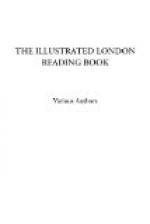Peter, after he had performed all the penances and duties of his pilgrimage, demanded an interview with Simeon, the Patriarch of the Greek Church at Jerusalem. Though the latter was a heretic in Peter’s eyes, yet he was still a Christian, and felt as acutely as himself for the persecutions heaped by the Turks upon the followers of Jesus. The good prelate entered fully into his views, and, at his suggestion, wrote letters to the Pope, and to the most influential Monarchs of Christendom, detailing the sorrows of the faithful, and urging them to take up arms in their defence. Peter was not a laggard in the work. Taking an affectionate farewell of the Patriarch, he returned in all haste to Italy. Pope Urban II. occupied the apostolic chair. It was at that time far from being an easy seat. His predecessor, Gregory, had bequeathed him a host of disputes with the Emperor Henry IV., of Germany; and he had made Philip I., of France, his enemy. So many dangers encompassed him about that the Vatican was no secure abode, and he had taken refuge in Apulia, under the protection of the renowned Robert Guiscard. Thither Peter appears to have followed him, though the spot in which their meeting took place is not stated with any precision by ancient chroniclers or modern historians. Urban received him most kindly, read with tears in his eyes the epistle from the Patriarch Simeon, and listened to the eloquent story of the Hermit with an attention which showed how deeply he sympathised with the woes of the Christian Church.
[Illustration: PETER THE HERMIT PREACHING THE FIRST CRUSADE.]
Enthusiasm is contagious, and the Pope appears to have caught it instantly from one whose zeal was so unbounded. Giving the Hermit full powers, he sent him abroad to preach the Holy War to all the nations and potentates of Christendom. The Hermit preached, and countless thousands answered to his call. France, Germany, and Italy started at his voice, and prepared for the deliverance of Zion. One of the early historians of the Crusade, who was himself an eye-witness of the rapture of Europe, describes the personal appearance of the Hermit at this time. He says that there appeared to be something of divine in everything which he said or did. The people so highly reverenced him, that they plucked hairs from the mane of his mule, that they might keep them as relics. While preaching, he wore, in general, a woollen tunic, with a dark-coloured mantle which fell down to his heels. His arms and feet were bare, and he ate neither flesh nor bread, supporting himself chiefly upon fish and wine. “He set out,” said the chronicler, “from whence I know not; but we saw him passing through towns and villages, preaching everywhere, and the people surrounding him in crowds, loading him with offerings, and celebrating his sanctity with such great praises, that I never remember to have seen such honours bestowed upon any one.” Thus he went on, untired, inflexible, and full of devotion, communicating his own madness to his hearers, until Europe was stirred from its very depths.




